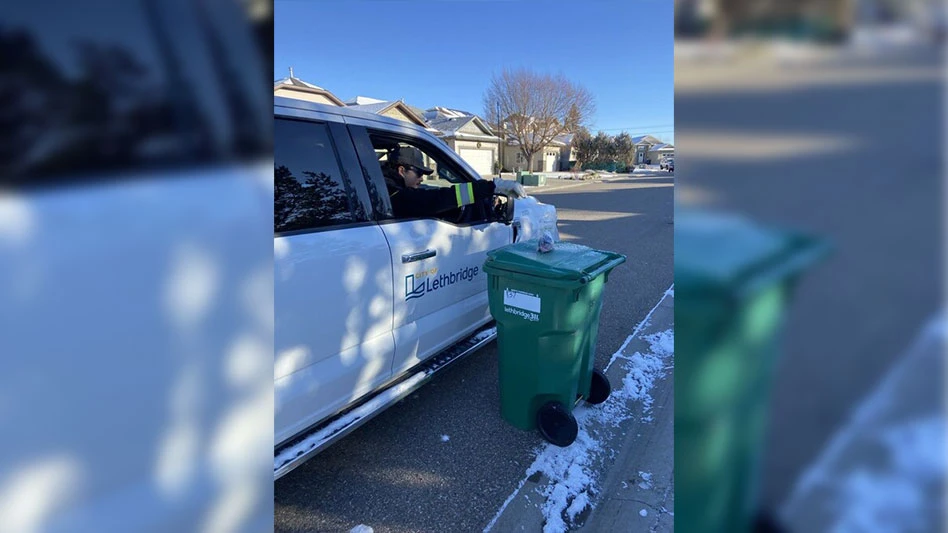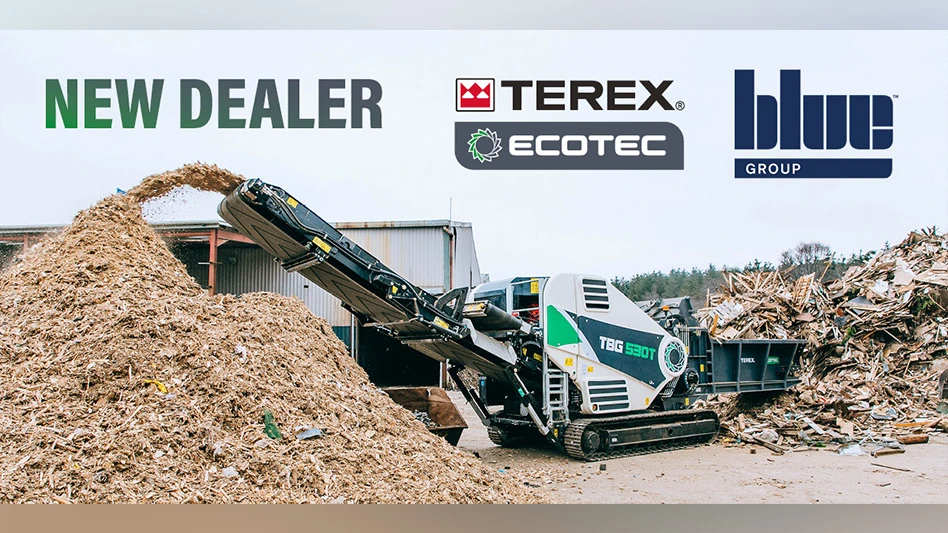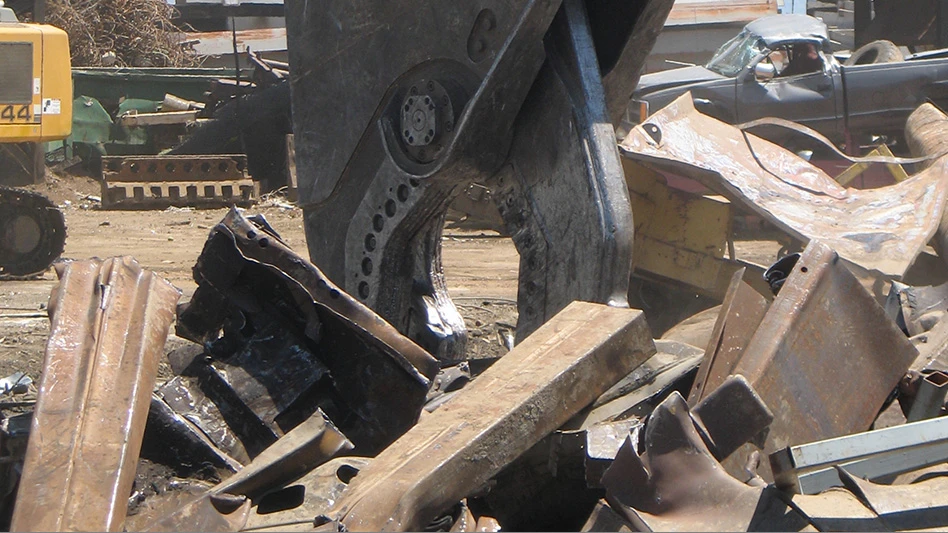
Photo courtesy of Evident
The primary goal of metal recyclers is to quickly and accurately identify, verify and sort alloys to maximize their return on investment. The materials found in a scrapyard can be highly diverse, ranging from ferrous to nonferrous alloys, including stainless steel, aluminum, copper and nickel alloys.
Hand-held XRF analyzers are invaluable tools for inspecting incoming raw materials and verifying grade specifications before shipping material according to a customer’s specifications. For example, 304 and 316 stainless steels have distinct chemical compositions used for different applications, so they must be accurately separated.

Hand-held XRF analyzers—often referred to as XRF guns or XRF metal analyzers—are used daily in many scrapyards. XRF, or X-ray fluorescence, technology provides the full chemical composition of alloys (except for carbon), with concentration ranges from hundredths of a percent to one hundred percent, depending on the grade and element. These devices can offer fast and precise results, so operators can test and sort a wide variety of alloys in a few seconds. They also are easy to use and require minimal sample preparation, making them widely applied in the metal recycling industry.
This article explores how to make the most of hand-held XRF technology for metal recycling.
Durability and performance in tough environments
Scrapyards present harsh conditions for analytical instruments: exposure to dust, humidity and shocks is common. A rugged, reliable XRF analyzer helps ensure long-term durability, reduces ownership costs and increases uptime.
Hand-held XRF analyzers must be built to withstand environmental temperatures ranging from −10 C to 45 C (14 F to 113 F) without operational interruptions (100 percent duty cycle). Key durability features such as IP-rated protection against dust and water splashes, drop testing according to military standards and comprehensive warranties (such as three years of protection) can provide metal recyclers with peace of mind and confidence in their investment.
Hand-held XRFs optimized for faster sorting
Quick decision-making is essential to maximize productivity in scrapyards. A fast and easy-to-use hand-held XRF analyzer helps increase throughput during the day. To accommodate different working styles, analyzers should allow customization of the user interface, such as:
listing elements of interest at the top of the results, sorted by name or concentration; and
- displaying real-time messages that aid in decision-making, such as familiar trade or grade names and special handling instructions that reduce training time and improve efficiency.
In addition, password-protected configurations help maintain consistent instrument settings across different applications or operators. This helps ensure that the settings remain unchanged from shift to shift for repeatable and high-quality sorting.
Sorting can be improved further through customizable libraries. Preloaded alloy grade libraries based on international standards, such as DIN (Deutsches Institut für Normung), EN (European Standards), ASTM (American Society for Testing and Materials) and JIS (Japanese Industrial Standards), can be customized by modifying grade specifications or loading additional libraries. An independent library for tramp elements, such as tin or nickel in copper alloys (considered residuals, as marked in Figure 1 as “Resid.”), can speed up and make identification more robust. These residual elements do not influence the primary grade classification.
Lastly, a clear and visual display of test results—including grade names, specifications and elements that exceed tolerances—helps operators quickly interpret the results. This enables confident decision-making and reduces the risk of human error.

Figure 1. Example of trace elements (residuals, shown as Resid.) displayed on a hand-held XRF analyzer.
Ergonomic XRF devices for all-day comfort
In the scrapyard, the ergonomics of a hand-held XRF analyzer play a crucial role in minimizing operator fatigue and improving productivity. For example, a balanced handle with a nonslip rubber grip improves comfort, making the device easy to hold and use during the day.
A holster accessory adds to this, keeping operators’ hands free to handle other tools as they move around the scrapyard. At the same time, it enables secure transport of the analyzer to the next testing site. Another advantage is a bright, large display, which provides easy reading in various lighting conditions.
Advancing accuracy and speed with new XRF technology
The latest generation of XRF analyzers must bring speed and confidence to the decision-making process. This is made possible with continuous hardware and software innovations that push the technology’s boundaries. Combining the latest silicon drift detector (SDD) with stable and low-noise electronics greatly improves the performance of XRF analyzers.
Consider the following example that compares nickel content in 304 stainless steel measured using two different XRF analyzers. In Figure 2a, a traditional PIN detector model, which converts light into electrical current, and the new SDD-based model (Figure 2b, c) yield similar accuracy, but the newer model significantly reduces measurement variability across 200 tests. Even when the testing time is reduced from 10 seconds to 5 seconds (Figure 2c), the repeatability remains high. This shows that this combination of leading-edge technology enables consistent accuracy from the first to the 200th test. At the same time, it reduces testing time without compromising performance on nickel content. ![]()
![]()
![]()

Figure 2: 200 repeats of an XRF test. (a) Top left: XRF analyzer with a PIN detector using a 10-second testing time. (b) Bottom left: XRF analyzer with an SDD detector using a 10-second testing time. (c) Right: XRF analyzer with an SDD detector using a 5-second testing time.
Optimizing XRF testing time for enhanced productivity
Many alloys contain light elements (magnesium to sulfur) that require longer testing time. However, these elements are not always needed to identify an alloy grade. By configuring the XRF analyzer to end the test once identification is completed and to extend the testing only when needed, operators can save significant time for improved productivity and throughput.
Best practices for hand-held XRF analyzers in the scrapyard
To achieve accurate results, following best practices is essential. As XRF analyzers can detect many elements at very low concentrations, they are highly sensitive to surface contamination from dust, paint or corrosion. To achieve the most accurate results, always remove contaminants from the analysis area using a grinder before testing.
XRF analyzers require minimal maintenance. The main focus should be on the protective film of the measurement aperture, which needs to remain clean and intact. If damaged or contaminated, the film must be replaced. Using self-adhesive film makes this change easy and quick without any tools: Simply peel off the film and replace it with a new one.
Choosing the right XRF analyzer for metal recycling
Hand-held XRF analyzers are available in a range of models and price points to meet different needs and budgets for metal recyclers. For cost efficiency, a good option is to choose a model that meets operational requirements without unnecessary features. The ability to upgrade the analyzer for applications such as catalytic converter material or precious metals recycling helps optimize the return on investment.
Hand-held XRF analyzers have become indispensable tools for metal recyclers, offering fast, accurate and reliable alloy identification in even the toughest scrapyard conditions. Their ability to provide detailed chemical composition analysis in seconds enables operators to maximize sorting efficiency, reduce material mix-ups and help ensure compliance with customer specifications.
With advancements in detector technology, durability features and user-friendly software, modern XRF analyzers improve productivity while minimizing downtime and maintenance. Customizable interfaces, optimized testing times and ergonomic designs further enhance usability, making these devices essential for daily operations in metal recycling.
By selecting the right XRF analyzer and following best practices for its use, recyclers can streamline their processes, reduce operational costs and ultimately maximize their return on investment. As technology continues to evolve, XRF analyzers likely will remain a key asset in the efficient and profitable recycling of metal alloys.
This article was submitted on behalf of Evident, a designer and manufacturer of a range of life science and industrial products, including microscopes, digital pathology solutions, nondestructive testing flaw detectors, X-ray fluorescence analyzers and video borescopes. More information is available at https://evidentscientific.com.
Latest from Recycling Today
- Phoenix Technologies closes Ohio rPET facility
- EPA selects 2 governments in Pennsylvania to receive recycling, waste grants
- NWRA Florida Chapter announces 2025 Legislative Champion Awards
- Goldman Sachs Research: Copper prices to decline in 2026
- Tomra opens London RVM showroom
- Ball Corp. makes European investment
- Harbor Logistics adds business development executive
- Emerald Packaging replaces more than 1M pounds of virgin plastic





